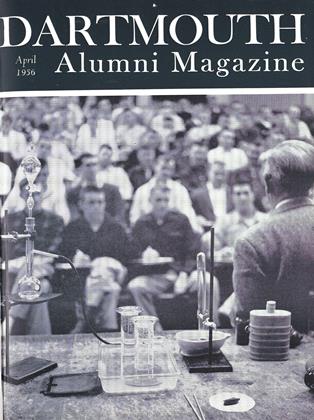By Nelson M.Blake '30. Syracuse: Syracuse UniversityPress, 1956. 341 pp. $4.00.
At a moment when an adequate water supply for our rapidly growing urban communities is becoming a serious problem, the publication of Professor Blake's scholarly and interesting history of the origins and development of a number of our great city water systems seems most timely. And for those of us who are apt to take for granted a plentiful supply of pure city water the book may prove something of an eye-opener.
It Was in the years just after the Revolution, and particularly in the 1790's, that Philadelphia, New York, Boston and Baltimore began to question the adequacy of their existing water supplies, derived mainly from public and private wells and from rain water cisterns. Not only were many of the wells tending to run dry, increasing the fire hazards, but contamination from the primitive sewerage facilities of the day was making the use of well water a menace to the public health. Moreover, it was currently believed by the more thoughtful that the terrible yellow fever epidemics in Philadelphia and New York in the 1790's might have been less disastrous had an adequate supply of water been available both for drinking purposes and for flushing the streets.
By the turn of the eighteenth century in the above mentioned cities the necessity of an increased supply of pure water was generally recognized, but for many years there was a bitter struggle, often politically motivated, over whether the projected water systems should be privately or publicly owned. In the end the responsibility of the city for providing its citizens with a copious supply of water was to be widely acknowledged. Almost as sharply contested was the question as to where the water was to be obtained. Was it to come from nearby sources or from more distant lakes and rivers, providing more ample quantitites but at greater cost? In this connection it should be noted that our forefathers invariably underestimated the population growth and water needs of their communities, as, indeed, their descendants have in more recent years.
By 1860 the sixteen largest cities in the country had what seemed an adequate supply of water with the water works municipally owned in all but four. One hundred and twenty smaller towns also had water systems of which the majority, however, were privately owned. During the remaining years of the nineteenth and early years of the twentieth centuries, the number of city, town and even village water works increased steadily. These years also, thanks to the work of the bacteriologists, brought a growing awareness of the need of further protecting the public by filtering the water to ensure the highest possible standard of purity.
Although the author devotes most of his attention to the water history of Philadelphia, New York, Boston, and Baltimore in the years before the Civil War, when, indeed, most of the fundamental problems were solved, he does not neglect the subsequent vast expansion of the systems of these cities. There are also brief discussions of the water problems of a number of other cities, notably Chicago, Cleveland, San Francisco, and Los Angeles.
Professor Blake has rendered a real service to the social "historian and to the general public in giving us this long-neglected history of one of our most important municipal services.
 View Full Issue
View Full Issue
More From This Issue
-
 Feature
FeatureThe Hopkins Center Concept
April 1956 -
 Feature
FeatureTHE MOCK-DUEL MURDER
April 1956 By EDWARD CONNERY LATHEM '51 -
 Feature
FeatureELECTION-YEAR CONFERENCE
April 1956 By ROBERT H. GILE '56 -
 Feature
FeatureA Tuckerman Tradition
April 1956 By ROBERT S. MONAHAN '29 -
 Class Notes
Class Notes1918
April 1956 By ERNEST H. EARLEY, RICHARD A. HOLTON -
 Class Notes
Class Notes1929
April 1956 By CHRISTIAN E. BORN, JOHN W. MOXON









